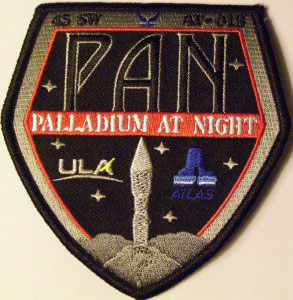PAN’s labyrinthby Dwayne Day
|
| What the heck is a “Palladium At Night?” |
But now something odd has happened that has satellite observers scratching their heads: the Air Force has announced the upcoming launch of a classified satellite from Cape Canaveral, but no government agency, certainly not the NRO, has claimed ownership. Its mission remains mysterious, as do other aspects of its existence. It was supposed to launch on August 12, but that date has now slipped to September 8.
The launch is designated PAN.
Craig Covault first broke the story back in May, noting that it was highly unusual for no agency to claim ownership of a launch. Covault also referred to the spacecraft as PAN, stating that: “The PAN designation is likely a meaningless term used simply so the mission can be called something that will not give away its identity during integration with the launcher. The National Reconnaissance Office (NRO) has used phony mission designations for years at the Cape.” Some Internet commentators joked that PAN stood for “pick a name.”
But recently the launch patch for the mission was publicly released and it reveals that the name of the launch is not PAN. PAN is merely a shortened version of: “Palladium At Night.”
Not that this helps much. What the heck is a “Palladium At Night?”
There are a lot of dictionary references for palladium, but two may be appropriate:
pal·la·di·um
1. A safeguard, especially one viewed as a guarantee of the integrity of social institutions: the Bill of Rights, palladium of American civil liberties.
2. A sacred object that was believed to have the power to preserve a city or state possessing it.
It seems reasonable, even likely, that the name is a reference to the satellite’s mission as a safeguard. But that doesn’t help much either.
Based upon scant pre-launch information, satellite watcher Ted Molczan has concluded that it is more likely that PAN is going to fly to geosynchronous orbit than a low Earth orbit or even medium Earth orbit. The specific Atlas launch vehicle being used for this mission could place up to 2,700 kilograms into a geostationary orbit.
| But all of this raises a question: why draw more attention to this launch by not simply slapping it with an NROL designation? |
A geosynchronous orbit is also consistent with Lockheed Martin’s announcement that the spacecraft uses one of the company’s commercial satellite buses, probably the A2100. The A2100 is also the core for the Space Based Infrared System missile warning satellites, so the bus does not have to be used for a comsat but could host another payload. Nevertheless, Molczan suspects that PAN could be the first of a fourth generation of Satellite Data System (SDS) communications relay satellites for the NRO. If the spacecraft flies to one of the known SDS slots in geosynchronous orbit, that would appear to be confirmation in his book.
SDS satellites first started flying in the 1970s with the mission of relaying data from low-flying photographic reconnaissance satellites back to ground stations in the United States. They operated in highly elliptical, highly inclined orbits so that a satellite low over the Soviet Union could point its antenna up over the North Pole and bounce off the SDS, which was also in line of sight with an American ground station. The second generation of SDS started flying in the 1990s, and there is an indication that the NRO started operating a second constellation in geosynchronous orbit during this period. A third generation began operating this decade.
But all of this raises a question: why draw more attention to this launch by not simply slapping it with an NROL designation? There must be a reason that the NRO is not claiming ownership, and the most likely reason is because the satellite belongs to a different government agency, such as DARPA or the Air Force. But that too raises a question of why they don’t simply acknowledge that it is theirs. The situation is not only confusing, it’s bizarre.
When PAN—er, Palladium At Night—finally gets launched, it may be possible to discern a little more of its intended mission. Or not. This is one mysterious bird.
